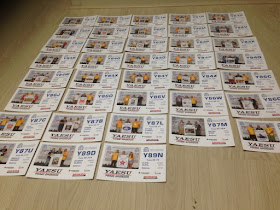Event: CQWW DX CW 2019
Logger: N1MM+ / CWskimmer
Station: Icom IC-7300 at 5% (5W)
Antenna: Vertical with CG3000 autotuner
Like last year I thought to try 160m QRP again. This year with a better radio (IC-7300) and the surprisingly unintentionally coupled antennatower/vertical antenna. I only took part for a few hours saturday evening/sunday morning/sunday evening aiming at 100 QSO. It went surprisingly good although it sometimes took me a lot of calling and repeating my call. Sometimes they mixed me up with EA4BAS which is sounding totally different in CW, however I can imagine when you only get 4BAS you're guessing. When I started N1MM+ saturday I thought I already figured out how to use CW/CAT control via one USB cable, however it seems I only configured FSK RTTY. So it took me a while to figure out what settings to use for CW but I managed to get it right in the end. The IC-7300 has adjustable very small filtering and it is very quiet to listen to especially with a very small filter. Listen to, yes, I actually listened and didn't do everything reading CWskimmer. I can't figure out calls send in CW but I can perfectly hear my own call, TU, 5NN and 14. I tried calling CQ once sunday morning but that didn't work out so all contacts are made S&P. The way I did it was tuning up the entire band and at the end tuning down working all the stations I could hear.
I didn't make use of the DX cluster since it has no use with QRP, you can only work reasonable loud stations. I was very surprised I could work VY2ZM (Canada) and S01WS (Western Sahara), VY2ZM was real 599 here. Over all, DX with QRP even with CW is just very difficult. 160m QRP, I think, is the most difficult section of them all. But with some patience and perserverance you can make a reasonable amount of contest points.
I know this is different from other parts of the world, Europe consists of so many DXCC it is no problem to work this amount of countries QRP. 37 in total. Strangly I miss Italy?? I didn't hear any Italian station on 160m. Can you imagine? It is almost impossible to not hear Italy on any HF band.
Listening is very important on 160m, especially with CW. With the small filter I used I could hear a station almost every KHz and for the first time ever in a contest I could hear stations, even the weak ones, without being disturbed by other signals. Something that isn't possible with the old IC-706 or the FT-817. I enjoyed this a lot and hope to do another effort next year....in the mean time I should really consider to learn some more CW...



















